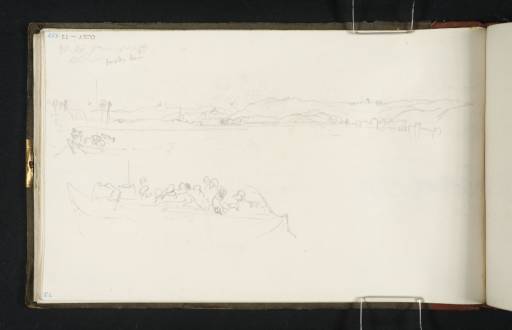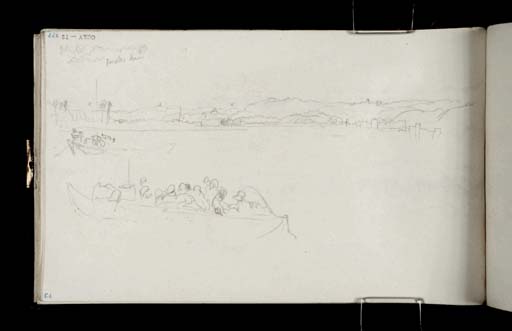Joseph Mallord William Turner Passenger Boats on the River Meuse near Coronmeuse, with Liège in the Distance to the South-West 1825
Image 1 of 2
Joseph Mallord William Turner,
Passenger Boats on the River Meuse near Coronmeuse, with Liège in the Distance to the South-West
1825
Joseph Mallord William Turner 1775–1851
Folio 73 Recto:
Passenger Boats on the River Meuse near Coronmeuse, with Liège in the Distance to the South-West 1825
D19522
Turner Bequest CCXV 73
Turner Bequest CCXV 73
Pencil on white wove paper, 113 x 189 mm
Inscribed by Turner in pencil ‘Smoke [?Be...]’ top left, below puffs of smoke
Inscribed by John Ruskin in blue ink ‘73’ bottom left and ‘277’ top left, both upside down
Stamped in black ‘CCXV – 73’ top left, upside down
Inscribed by Turner in pencil ‘Smoke [?Be...]’ top left, below puffs of smoke
Inscribed by John Ruskin in blue ink ‘73’ bottom left and ‘277’ top left, both upside down
Stamped in black ‘CCXV – 73’ top left, upside down
Accepted by the nation as part of the Turner Bequest 1856
References
1909
A.J. Finberg, A Complete Inventory of the Drawings of the Turner Bequest, London 1909, vol.II, p.664, CCXV 73, as ‘River scene. Probably the Meuse’.
This is the first of three variant views along a broad river (see also the verso and folio 74 recto; D19523–D19524), with buildings on the far bank and a distant spire among hills; Finberg only went so far as to suggest the setting was the Meuse.1 In this he was correct, as the view is south-westwards upriver towards Liège. The present drawing is precise enough in its rendering of the city to make out the spire of the cathedral, likely the broad tower of St Denis’s Church to its right, and the square tower of St Martin’s on the slopes beyond just to the right again, all overlooked by the bastions of the Citadel on the nearer crest to their right; compare the view upstream from within the city on folios 69 verso–70 recto (D19516–D19517).
The viewpoint appears to be east of the gentle bend round the meadows and racecourse shown on maps of the time, but the setting has radically changed, as a broad road now skirts the heavily industrialised Droixhe district on the south bank. The low buildings on the north side were at Coronmeuse, where the southern end of the 1930s Albert Canal now branches off from the Meuse, either side of commercial docks of the newly formed Ile Monsin, overlooked by landscaped ‘terrils’ (slag heaps) towards Bernalmont.
In the foreground are two heavily laden open boats, or possibly successive studies of the same craft; the nearest is full of passengers, many of whom are women in bonnets. After a long sequence of Liège views in the contemporary Holland sketchbook, numerous small sketches (Tate D19185–D19194; Turner Bequest CCXIV 174a–179) chart Turner’s meandering progress down the river to Maastricht, likely on such a boat; D19185 shows the city in the distance, perhaps from Coronmeuse. For views of Maastricht in the present book, see under folio 22 verso (D19440); among them is one on folio 74 verso (D19525), the reverse of the third variant on the present scene. See under folio 23 verso (D19442) for other views of Liège in this sketchbook and elsewhere.
Three loosely finished 1820s watercolours with distant hilltop fortifications beyond a river valley (Tate D20212–D20214; Turner Bequest CCXX F, G, H), were tentatively were linked with Liège by Finberg,2 possibly in relation to the views here (compare D20212 in particular). They have more recently been thought to be French subjects, but are at time of writing listed as showing Carisbrooke Castle on the Isle of Wight, and await further investigation.
Matthew Imms
September 2020
How to cite
Matthew Imms, ‘Passenger Boats on the River Meuse near Coronmeuse, with Liège in the Distance to the South-West 1825 by Joseph Mallord William Turner’, catalogue entry, September 2020, in David Blayney Brown (ed.), J.M.W. Turner: Sketchbooks, Drawings and Watercolours, Tate Research Publication, March 2023, https://www


